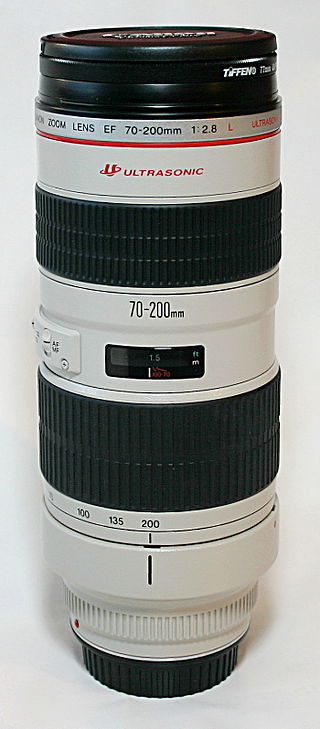Top Qs
Timeline
Chat
Perspective
Canon L lens
Camera lens manufactured by Canon From Wikipedia, the free encyclopedia
Remove ads
Canon's series of L lenses (Luxury lenses) are a professional line of photography lenses made by Canon. Canon has sold zoom and prime L-series lenses for the discontinued FD lens mount, for the current EF lens mount used on all Canon EOS SLR cameras and for the RF mount used on mirrorless interchangeable-lens cameras.
This article contains weasel words: vague phrasing that often accompanies biased or unverifiable information. (March 2009) |

Remove ads
Characteristics
Summarize
Perspective
Canon L series lenses have a distinctive red ring around the lens barrel and the letter "L" after the lens name.[1] Some models of L lenses utilize an infrared reflective heat shield coating.[2] Most L series lenses share a number of common characteristics not found in Canon's line of lower-end lenses: L lenses tend to be more durable, incorporating dust and water-resistant rubber seals on some models, as well as featuring optics of higher quality, with many lenses containing aspherically ground, fluorite or ultra-low dispersion glass elements. Their front elements do not rotate for the proper operation of some filters, such as circular polarizers. L lenses are often "fast", with maximum apertures commonly f/2.8 or f/4, and, with the exception of the RF 100–500 mm f/4.5–7.1L IS USM lens and the RF 1200 mm f/8L IS USM lens, never exceeding f/5.6. Prime L lenses have a much larger maximum aperture, such as Canon's current 50mm and 85mm L lenses with maximum apertures of f/1.2. All current L-series lenses have ultrasonic autofocus motors (USM) with exceptions of RF 10–20mm f/4 L IS STM, RF 20 mm f/1.4L VCM, RF 24 mm f/1.4L VCM, RF 35 mm f/1.4L VCM, RF 50 mm f/1.4L VCM lens, and extra communication pins, except for the specialist tilt-shift lenses which do not provide auto focus.

Larger sized L-lenses, such as the 70–200 mm, 100–400 mm zooms, and longer focal length primes (300 mm+), usually have an off-white barrel to reduce heat absorption under the sun that may otherwise affect the performance of the lens.[3]
Wide angle L-lenses typically have a gelatin filter holder on the mounting collar of the lens, which allows a gelatin to be installed behind the lens. Some telephoto L-lenses, such as the EF 70-200mm zoom lenses, or the EF 300mm f/4L IS USM do not have rear gelatin filter holders. Super-telephoto lenses such as the EF 500mm f/4L IS USM, or the EF 200mm f/2L IS USM have a rear 52mm drop-in filter holder which can be used to hold gelatin type filters.
According to Canon, its L series lenses:
Incorporating specialized optical materials such as synthetic fluorite, Super UD and UD glass, and large-aperture high-precision aspherical lenses, only lenses that perform to the highest photographic standards are allowed to bear the designation ‘L’.[1]
Remove ads
Lenses
EF mount zoom lenses
EF mount prime lenses
RF mount zoom lenses
RF mount prime lenses
Fixed zoom lenses
The Canon PowerShot Pro1 is the first in the Canon PowerShot family of point-and-shoot cameras to have an L-designated zoom lens ranging from 7.2 to 50.8 mm, equal to 28 to 200 mm in 35mm equivalent focal length. Its maximum aperture changes from f/2.4 to f/3.5, with focus driven by an ultrasonic motor.
Remove ads
Canon lens codes
On the back of Canon lenses is a six-digit code, which indicates where the lens was manufactured and when.
Example of a code "UV1212"
The first letter, 'U', represents the factory that made the lens. Three possible first letters are:
U = Utsunomiya F = Fukushima O = Ōita
The second letter, 'V', represents the year of manufacture
A = 1960, 1986, 2012 B = 1961, 1987, 2013 C = 1962, 1988, 2014 D = 1963, 1989, 2015 E = 1964, 1990, 2016 F = 1965, 1991, 2017 G = 1966, 1992, 2018 H = 1967, 1993, 2019 I = 1968, 1994, 2020 J = 1969, 1995 K = 1970, 1996 L = 1971, 1997 M = 1972, 1998 N = 1973, 1999 O = 1974, 2000 P = 1975, 2001 Q = 1976, 2002 R = 1977, 2003 S = 1978, 2004 T = 1979, 2005 U = 1980, 2006 V = 1981, 2007 W = 1982, 2008 X = 1983, 2009 Y = 1984, 2010 Z = 1985, 2011
The next two digits represent the month the lens was manufactured.
The last two digits are for internal Canon use.
Therefore, the example (pictured) of UV0512 means the lens was made in the Utsunomiya, Japan factory in May 2007.
See also
References
External links
Wikiwand - on
Seamless Wikipedia browsing. On steroids.
Remove ads
